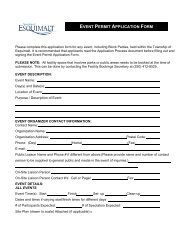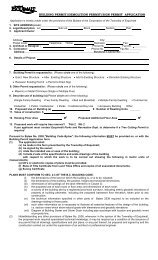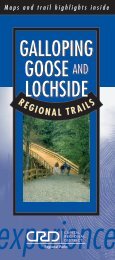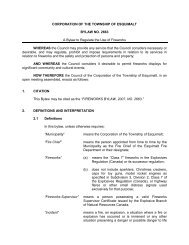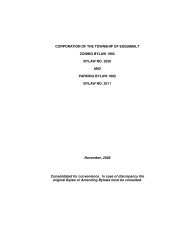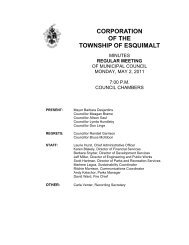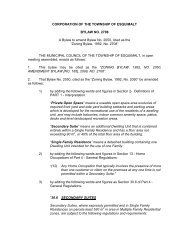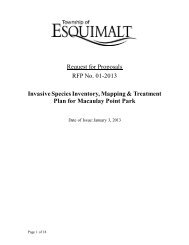Old Esquimalt Village Area - Township of Esquimalt
Old Esquimalt Village Area - Township of Esquimalt
Old Esquimalt Village Area - Township of Esquimalt
You also want an ePaper? Increase the reach of your titles
YUMPU automatically turns print PDFs into web optimized ePapers that Google loves.
<strong>Township</strong><br />
Walking Tours<br />
Constance Avenue is named for HMS Constance, the first warship to drop<br />
anchor in <strong>Esquimalt</strong> Harbour; Nelson Street for Viscount Horatio Nelson who<br />
as Vice-Admiral <strong>of</strong> the White HMS Victory defeated the French at the Battle<br />
<strong>of</strong> Trafalgar 21st October 1805; Sturdee Street after Admiral Sturdee; Foster<br />
Street for George Foster Foster, <strong>Esquimalt</strong> District Member <strong>of</strong> the House <strong>of</strong><br />
Assembly for Vancouver Island in 1860 and Grafton Street after HMS Grafton<br />
the last flagship (1903) on the Pacific Coast.<br />
Walk west to Grafton Street, turn right. Walk north to <strong>Esquimalt</strong> Road.<br />
At the corner, St. Paul’s historic Naval and Garrison Church was originally<br />
built in 1866 at the foot <strong>of</strong> Signal Hill overlooking Church Bay. Architect<br />
Thomas Trounce supervised the construction.<br />
Walking Tour Three: <strong>Old</strong> <strong>Esquimalt</strong> <strong>Village</strong> <strong>Area</strong><br />
Begin the walk at the Tudor House at the junction <strong>of</strong> <strong>Esquimalt</strong> and Admirals<br />
Road. Parking is available at the rear <strong>of</strong> the building. Rev. John P. Hicks<br />
opened this building in 1904 as The Soldiers and Sailors’ Home. Under the<br />
proprietorship <strong>of</strong> Mrs. Ranns, later Mrs. “Ma” Quinn, it was known as The<br />
Soldiers and Sailors’ Rest. The <strong>Township</strong> <strong>of</strong> <strong>Esquimalt</strong> incorporated at a<br />
meeting held in this building 1st September 1912. The Tudor House opened<br />
in 1935 when Mount View Holdings received the first liquor permit.<br />
When the laws against selling alcohol ended in 1924, Victoria remained<br />
“dry” while Royal Oak and <strong>Esquimalt</strong> remained “wet.” Beer was the only<br />
beverage sold and only by the glass. <strong>Esquimalt</strong> was known for its Public<br />
Houses; The Gorge Hotel, The Halfway House (now <strong>Esquimalt</strong> Inn), The Tudor<br />
House, <strong>Esquimalt</strong> Hotel/End House and the Coach and Horses. Victoria<br />
remained “dry” until 1952.<br />
Walk south to the <strong>Esquimalt</strong> United Church at the corner <strong>of</strong> Lyall Street and<br />
Admirals Road. Completed in 1913, the church, formerly the <strong>Esquimalt</strong> Naval<br />
and Military Methodist Church, was founded with the support <strong>of</strong> the crew <strong>of</strong><br />
HMCS Rainbow.<br />
HMS Rainbow and HMS Niobe (Halifax, N.S.) became Canada’s first warships<br />
when the Naval Service <strong>of</strong> Canada (later Royal Canadian Navy) was founded<br />
in 1910.<br />
St. Paul’s, a fine example <strong>of</strong> Gothic Vernacular Style, is one <strong>of</strong> the oldest<br />
buildings in <strong>Esquimalt</strong>. In 1904, the church was taken apart, removed to its<br />
present site, and reconstructed under the supervision <strong>of</strong> architect Thomas<br />
Woodgate. George Foster Foster donated the land for the church site. His<br />
house “The Hermitage,” later home to the Gillespie family, stood adjacent to<br />
the property.<br />
Interesting artifacts and memorials, including the laid up colours <strong>of</strong> the Royal<br />
Canadian Navy, the Canadian Merchant Marines, the <strong>Old</strong> Contemptibles and<br />
the Burma Star, hang in the church and are worthy <strong>of</strong> a closer look. Enjoy the<br />
RCN memorial windows.<br />
The Organ was given heritage status in 2006. The church was designated<br />
heritage in 1999.<br />
Phone St. Paul’s at 250-388-6833 for service times or to arrange a tour.<br />
Cross <strong>Esquimalt</strong> Road to the north side.<br />
“Devon Cottage,” the Regency Style<br />
house at 1388 <strong>Esquimalt</strong> Road, was<br />
built by John Day who owned The<br />
<strong>Esquimalt</strong> Hotel located on Wharf<br />
The Tudor House (right)<br />
1253 Lyall Street (below)<br />
On the southeast corner 1253 Lyall Street, a Queen Anne Cottage built<br />
about 1910 by Charles James Jordan. For many years, it was the home <strong>of</strong><br />
Commander Rowland Bourke, VC, DSO,Legion <strong>of</strong> Merit and Croix de Guerre.<br />
Bourke received the Victoria Cross for valour at Zeebrugge-Ostend during<br />
the First World War. He was instrumental in the formation <strong>of</strong> the Fishermen’s<br />
Volunteer Reserve just before the Second World War.<br />
Turn right on Lyall Street, walk west through land originally surveyed as<br />
Suburban Lots. These streets are some <strong>of</strong> the earliest in the municipality. A<br />
jaunt south down any <strong>of</strong> them will reveal a variety <strong>of</strong> heritage homes, lovely<br />
gardens, beautiful ocean views and a few small waterfront parks.<br />
www.My<strong>Esquimalt</strong>.com 1
Street/Pioneer Street in the <strong>Old</strong> <strong>Esquimalt</strong> <strong>Village</strong> (now HMC Dockyard).<br />
Later under the proprietorship <strong>of</strong> the Brunsdon family, the hotel was known<br />
as The Bucket <strong>of</strong> Blood. Arthur Lockley, a former reeve <strong>of</strong> <strong>Esquimalt</strong> lived in<br />
Devon Cottage until his death in the rose garden in 1944. The house was<br />
restored by Walter Sharpe and designated heritage in 2000.<br />
In 1901, Jessie Price Day, John’s first wife, built “Glenday” at 1382<br />
<strong>Esquimalt</strong> also in the Regency Style. Both <strong>of</strong> these houses were built on<br />
Suburban Lot 27 originally owned by George Foster Foster. In 1919, the<br />
second story and the bow-front window were added.<br />
Continue east on <strong>Esquimalt</strong> Road.<br />
Walk to Nelson Street and turn left. Just after Miles Street view 619 Nelson<br />
Street built between 1897-98 by Charles Jordan. Charles moved to B.C.<br />
in 1892 and was employed by the Royal Engineers as foreman on various<br />
fortification projects in <strong>Esquimalt</strong> and Victoria. Charles also built 1253 Lyall<br />
Street.<br />
Take Miles Street through to Constance Avenue. Turn left and continue north.<br />
On your left, 620 Constance Avenue was built by Alfred Nunn about 1912.<br />
The Nunn family lived in the house until 1944. His father, Robert Henry<br />
Nunn, was a special constable and the first poundkeeper for the <strong>Township</strong>.<br />
He carried out his duties on horseback.<br />
Frederick George and Alma Neild Luscombe built 638 Constance about<br />
1910. Fred served 12 years with the Royal Navy. He was a hard hat diver.<br />
Their son George was a diver with the Royal Canadian Navy. After Fred’s<br />
death, Alma continued living in the house until 1980.<br />
Continue to Astle Street.<br />
Turn right, continue to Admirals Road. As you go south on Admirals Road, on<br />
your left, 649 Admirals Road, “Ervyger” was built in 1908 for Rev. William<br />
Washington Bolton and his wife Agnes Jane Bushby. Rev. Bolton founded<br />
Clockwise from top: Beaumont Post Office, 620 Constance Avenue<br />
and 649 Admiral’s Road<br />
the University School for Boys (now St. Michael’s University School). The<br />
foundation and first storey are cement brick, scored to look like masonry.<br />
Architect Peter Cotton lived in the house from 1969 to 1980. Despite the<br />
recommendation <strong>of</strong> the building inspector in 1970 to demolish the house,<br />
he renovated it! In 1996, Bill and Debrah Patterson again restored, then<br />
adapted the house for new use. The house was designated heritage in 1996.<br />
Historically known as Beaumont, this was the old Beaumont Post Office area<br />
for <strong>Esquimalt</strong>. The Tudor House is in sight and the walk ends here. Pop in for<br />
some good Pub Fare. There are many restaurants and c<strong>of</strong>fee shops in this<br />
area and all are worthy <strong>of</strong> a visit.<br />
Constance Cove<br />
Lang Cove<br />
ASTLE<br />
DND<br />
Property<br />
1388<br />
GRAFTON<br />
St Paul’s<br />
Church<br />
1382<br />
ESQUIMALT<br />
FOSTER<br />
LYALL<br />
STURDEE<br />
SUSSEX<br />
NELSON<br />
619<br />
638<br />
620<br />
MILES<br />
CONSTANCE<br />
<strong>Old</strong> Beaumont<br />
Post Office<br />
ADMIRALS<br />
649<br />
Tudor House<br />
Start / Finish<br />
1253<br />
Robert Henry Nunn, Special Constable<br />
Written by Sherri K. Robinson. Photos: <strong>Esquimalt</strong> Municipal Archives and Josh McCulloch.<br />
Walking Tour Three: <strong>Old</strong> <strong>Esquimalt</strong> <strong>Village</strong> <strong>Area</strong><br />
2




